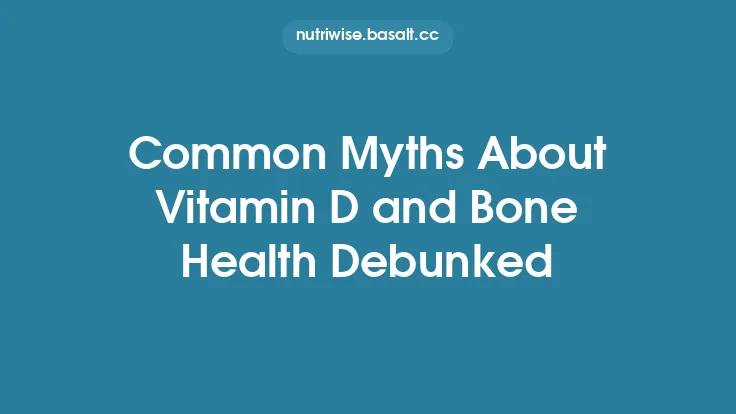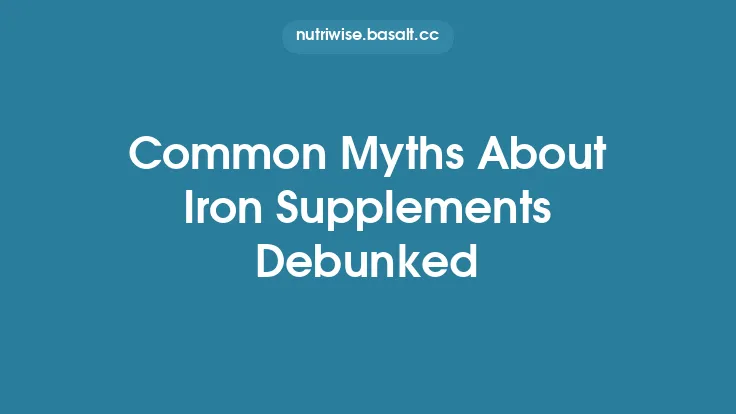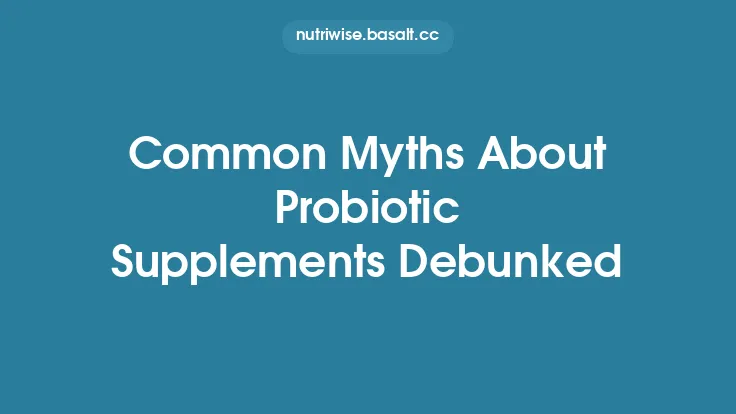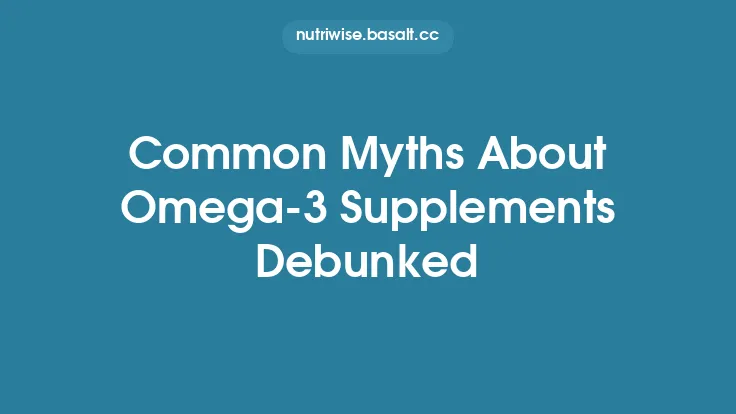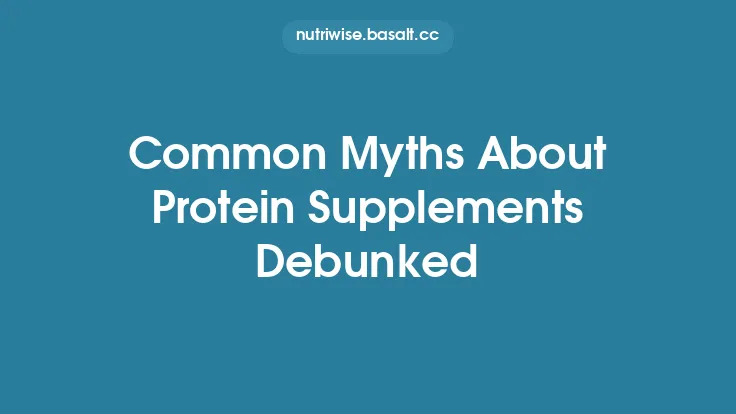The world of nutrition is riddled with catchy headlines and well‑meaning advice that can blur the line between fact and fiction. When it comes to essential minerals—those inorganic nutrients our bodies cannot synthesize—misconceptions are especially common. While the science of minerals is nuanced, many of the myths that circulate are surprisingly simple to debunk. Below, we untangle ten of the most persistent misunderstandings, grounding each correction in evergreen, evidence‑based information that remains relevant regardless of the latest diet trend.
Myth 1 – “All minerals are the same, so any source will do”
Reality: Essential minerals differ dramatically in atomic structure, biological role, and physiological requirement. Calcium, for example, is a major component of bone matrix, whereas zinc functions as a catalytic co‑factor in over 300 enzymes. Even within a single mineral, the chemical form matters: magnesium oxide delivers far less absorbable magnesium than magnesium citrate. Treating minerals as interchangeable ignores the specific pathways each element follows to support health.
Why the myth persists: Marketing language often lumps “minerals” together for simplicity, and many supplement labels list a “mineral blend” without specifying the individual elements or their bioavailability.
Takeaway: Evaluate minerals individually. Look for clear labeling that identifies the exact element, its dosage, and the chemical form (e.g., “zinc picolinate” vs. “zinc oxide”).
Myth 2 – “More of a mineral is always better”
Reality: Essential minerals have a narrow therapeutic window. While deficiency can impair function, excess intake can be toxic or interfere with the absorption of other nutrients. For instance, chronic high intake of iron can cause oxidative stress and damage the liver, whereas too much selenium can lead to selenosis, characterized by hair loss and neurological symptoms.
Why the myth persists: The “more is better” mindset is reinforced by supplement advertisements promising “maximum potency” without acknowledging safety thresholds.
Takeaway: Respect the Recommended Dietary Allowance (RDA) and Upper Intake Level (UL) established by health authorities. If you suspect a deficiency, seek professional testing before self‑prescribing high‑dose supplements.
Myth 3 – “If I eat a balanced diet, I never need mineral supplements”
Reality: A well‑rounded diet supplies most essential minerals for many people, but several real‑world factors can create shortfalls. Soil depletion, food processing, and cooking methods can reduce mineral content in foods. Additionally, certain health conditions (e.g., celiac disease, chronic kidney disease) or medications (e.g., proton‑pump inhibitors) impair mineral absorption or increase losses.
Why the myth persists: The phrase “balanced diet” is vague and often interpreted subjectively, leading people to assume any variety of foods automatically meets mineral needs.
Takeaway: Use a balanced diet as the foundation, but recognize circumstances where targeted supplementation is justified—especially for groups like pregnant women (higher iron and iodine needs) or older adults (greater calcium and magnesium requirements).
Myth 4 – “All essential minerals are abundant in drinking water”
Reality: While water can contribute modest amounts of minerals such as calcium, magnesium, and potassium, the concentrations vary widely based on geographic source and treatment processes. Municipal water is often softened or filtered, stripping it of many minerals. Conversely, some bottled waters are marketed for high mineral content, but the actual contribution to daily needs is usually small.
Why the myth persists: The notion of “hard water” being “good for you” is popular, and some health blogs tout mineral‑rich water as a shortcut to meeting daily requirements.
Takeaway: Treat water as a supplemental source, not a primary one. Verify mineral content through lab reports or reputable labeling if you rely on water for a significant portion of your intake.
Myth 5 – “Mineral deficiencies are rare in developed countries”
Reality: Subclinical deficiencies are more common than most people realize. For example, up to 30 % of U.S. adults have inadequate magnesium intake, and iodine deficiency persists in certain regions despite iodized salt programs. Women of reproductive age often fall short on iron, and older adults frequently lack sufficient calcium and vitamin D, which together affect bone health.
Why the myth persists: Public health successes (e.g., widespread fortification) create a perception that deficiencies are a thing of the past.
Takeaway: Periodic dietary assessments or blood tests can uncover hidden shortfalls. Addressing even mild deficiencies can improve energy levels, immune function, and long‑term disease risk.
Myth 6 – “All mineral supplements are safe and free of side effects”
Reality: Supplements are biologically active substances and can interact with medications, other nutrients, or underlying health conditions. High‑dose calcium supplements, for instance, have been linked in some studies to an increased risk of kidney stones and cardiovascular events when taken without medical guidance. Iron supplements can cause gastrointestinal irritation and, in excess, contribute to oxidative damage.
Why the myth persists: The “natural” label on supplements creates a false sense of safety, and adverse events are under‑reported compared to prescription drugs.
Takeaway: Choose supplements that have undergone third‑party testing (e.g., USP, NSF). Consult a healthcare professional before initiating a new mineral regimen, especially if you are pregnant, nursing, or managing chronic disease.
Myth 7 – “Mineral interactions are insignificant”
Reality: Minerals can compete for absorption pathways or influence each other’s metabolism. High dietary zinc can impede copper absorption, leading to a secondary copper deficiency. Excessive calcium may reduce iron and magnesium uptake. These interactions are not merely academic; they can affect clinical outcomes, such as anemia or impaired wound healing.
Why the myth persists: Interaction details are often omitted from product labels, and the complexity can be intimidating for consumers.
Takeaway: When supplementing multiple minerals, stagger doses (e.g., take iron in the morning and calcium at night) or use a balanced multivitamin/mineral formula designed to minimize antagonistic effects.
Myth 8 – “Organic minerals are always superior to inorganic ones”
Reality: The terms “organic” and “inorganic” in mineral supplements refer to the chemical bonding of the mineral to carbon‑containing molecules (e.g., chelated forms). While chelated minerals can improve solubility and sometimes absorption, the superiority is not universal. For some minerals, such as sodium, the inorganic form (sodium chloride) is perfectly adequate. Moreover, the clinical relevance of modest differences in bioavailability is often negligible when the overall intake meets the RDA.
Why the myth persists: “Organic” carries a health‑halo effect, and manufacturers use it as a marketing differentiator.
Takeaway: Evaluate the evidence for each specific mineral. If a chelated form offers a clear advantage for a known absorption issue (e.g., magnesium glycinate for individuals with gastrointestinal sensitivity), it may be worth the extra cost. Otherwise, standard inorganic salts are generally sufficient.
Myth 9 – “Detox teas and cleanses boost my mineral status”
Reality: Many “detox” products contain diuretics (e.g., caffeine, senna) that increase urinary excretion of water‑soluble minerals like potassium and magnesium. Some also include laxatives that can lead to loss of electrolytes. Rather than enhancing mineral status, these products can create a net deficit, especially if used repeatedly.
Why the myth persists: The promise of rapid “flushing” of toxins is alluring, and the term “detox” is loosely defined in marketing.
Takeaway: Rely on evidence‑based strategies—balanced nutrition, adequate hydration, and regular physical activity—to support the body’s natural detoxification pathways. If you choose a cleanse, limit its duration and monitor electrolyte balance.
Myth 10 – “My mineral needs don’t change with age, activity level, or health status”
Reality: Physiological demands evolve throughout life. Adolescents require more calcium and phosphorus for skeletal growth, while post‑menopausal women need higher calcium and vitamin D to counteract bone loss. Athletes lose sodium, potassium, and magnesium through sweat, necessitating replenishment. Chronic conditions such as hypertension may call for reduced sodium intake, whereas certain gastrointestinal disorders increase the need for zinc and iron.
Why the myth persists: General nutrition guidelines are often presented as one‑size‑fits‑all, ignoring individual variability.
Takeaway: Periodically reassess your mineral intake in the context of life stage, activity level, and health changes. Tailor dietary choices and, when appropriate, supplement regimens to reflect these shifting requirements.
Putting the Pieces Together: A Practical Approach to Mineral Truth
- Start with Food: Prioritize whole, minimally processed foods known to be rich in specific minerals—leafy greens for calcium, legumes for magnesium, seafood for iodine and selenium. This strategy naturally balances intake and reduces the risk of excess.
- Identify Gaps: Use a simple food‑frequency questionnaire or a brief nutrient analysis (many reputable apps offer this) to spot potential shortfalls. If a pattern emerges—e.g., low intake of iron‑rich foods—consider targeted dietary adjustments before reaching for a supplement.
- Choose Wisely: When supplementation is warranted, select products that:
- Clearly list the elemental mineral amount (e.g., “15 mg elemental zinc”).
- Specify the chemical form.
- Carry a third‑party verification seal.
- Provide dosage instructions that respect the UL.
- Mind Interactions: Space out minerals that compete for absorption. For example, take iron on an empty stomach with vitamin C to enhance uptake, and schedule calcium later in the day.
- Monitor and Adjust: Periodic blood work (e.g., serum ferritin for iron, serum magnesium) can confirm whether interventions are effective. Adjust dosages based on results and any emerging health concerns.
- Stay Informed: Nutrition science evolves, but the core principles—adequate variety, awareness of individual needs, and cautious supplementation—remain evergreen. Rely on reputable sources such as peer‑reviewed journals, government dietary guidelines, and qualified health professionals.
Bottom Line
Essential minerals are indispensable, yet the landscape of myths surrounding them can lead to both under‑ and over‑consumption. By recognizing that minerals are distinct, have optimal ranges, interact with each other, and are influenced by diet, age, and health status, you can navigate the sea of misinformation with confidence. Embrace a food‑first philosophy, supplement judiciously when needed, and keep an eye on the science—your body will thank you with better energy, stronger bones, and a more resilient immune system.

